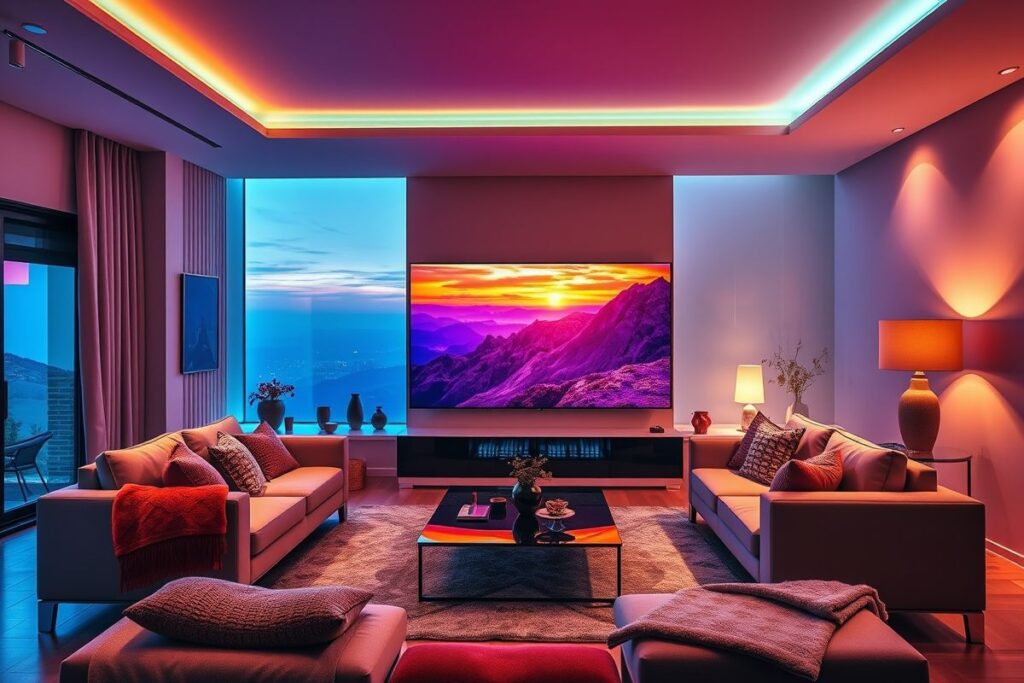From the flickering flames of candles to the vibrant glow of LED screens, home entertainment has undergone a remarkable transformation. Now, a new era is dawning, powered by the revolutionary technology of Organic Light Emitting Diodes, or OLED. Offering unparalleled picture quality, energy efficiency, and design flexibility, OLED is poised to redefine how we experience movies, television, and gaming in the comfort of our homes. Forget the limitations of traditional displays; OLED represents a quantum leap forward, delivering an immersive viewing experience that was once the stuff of science fiction. Prepare to be captivated by perfect blacks, breathtaking colors, and lightning-fast response times. This is more than just an upgrade; it’s a paradigm shift. This article will explore why OLED is the future of home entertainment and why you should be excited about this groundbreaking technology.

Unrivaled Picture Quality: A Feast for the Eyes
The Magic of Perfect Black
OLED’s unique ability to achieve perfect black is the cornerstone of its superior image quality. Unlike LCDs that rely on backlights, each OLED pixel emits its own light. This means when a pixel is off, it’s truly off, resulting in absolute black. This absence of light leakage produces an infinite contrast ratio, making images appear remarkably lifelike and three-dimensional.
This profound difference is especially noticeable in dark scenes. Details that would be lost in the murky grays of an LCD screen are vividly rendered on an OLED display, revealing subtle nuances and textures. Imagine watching a night sky speckled with stars, each one pinprick sharp against the inky blackness. This level of detail is simply unattainable with conventional display technologies.
The impact of perfect black extends beyond just improved contrast. It also enhances color accuracy and saturation. With no backlight bleed to wash out colors, OLED displays can reproduce a wider color gamut, resulting in more vibrant and realistic hues.
Breathtaking Color and Wide Viewing Angles
OLED technology unlocks a world of vibrant and true-to-life colors. The individual light emission of each pixel allows for precise color control, delivering a wider color gamut and greater color accuracy than traditional LCD displays. From the deepest reds to the most vibrant greens, OLED brings every scene to life with stunning realism.
Furthermore, OLEDs offer incredibly wide viewing angles. Unlike LCDs, which can suffer from color shifting and reduced brightness when viewed from the side, OLED maintains its picture quality even at extreme angles. This means everyone in the room can enjoy the same breathtaking visuals, regardless of their seating position.
This wide viewing angle advantage is particularly beneficial for larger screens and group viewing scenarios. Whether you’re hosting a movie night or watching the big game with friends, everyone will have a perfect view of the action.
Beyond the Picture: Additional OLED Advantages
Lightning-Fast Response Time and Smooth Motion
OLED’s incredibly fast response time is a boon for gamers and action movie enthusiasts. With virtually no motion blur, fast-paced scenes are rendered with crystal-clear clarity, ensuring you don’t miss a single detail. This responsiveness is crucial for competitive gaming, where split-second reactions can make all the difference.
This superior motion handling eliminates the ghosting and blurring that can plague LCDs, providing a smoother and more immersive viewing experience. Whether you’re watching a high-octane car chase or playing a fast-paced video game, OLED delivers unparalleled clarity and responsiveness.
The absence of motion blur also reduces eye strain, making extended viewing sessions more comfortable. This is a significant advantage for gamers, movie buffs, and anyone who spends a lot of time in front of a screen.
Energy Efficiency and Design Flexibility
OLED displays are inherently more energy-efficient than LCDs. Because each pixel generates its own light, there’s no need for a power-hungry backlight. This translates to lower power consumption, reducing your electricity bill and minimizing your environmental impact.
The self-emissive nature of OLED also allows for incredibly thin and flexible displays. This design flexibility opens up a world of possibilities for manufacturers, from curved screens to foldable TVs that can be rolled up and stored away when not in use.
This flexibility extends to form factor as well, allowing for transparent displays and other innovative designs that are simply not possible with traditional LCD technology. The future of display technology is not just about better picture quality, it’s also about seamless integration into our living spaces.
The Future of Home Entertainment: OLED’s Expanding Influence
Gaming and Beyond: A New Era of Immersion
OLED technology is transforming the gaming experience, offering unparalleled visual fidelity and responsiveness. The perfect blacks and vibrant colors bring virtual worlds to life, while the lightning-fast response time ensures a smooth and immersive gaming experience.
Beyond gaming, OLED is also making its mark in virtual reality and augmented reality applications. The high refresh rates and low latency of OLED displays are crucial for creating realistic and immersive VR/AR experiences.
As OLED technology continues to evolve, we can expect even more innovative applications in the future. From interactive displays to holographic projections, OLED has the potential to revolutionize how we interact with digital content.
The Evolution of Television: A Premium Viewing Experience
OLED is rapidly becoming the gold standard for television displays. The superior picture quality, coupled with the sleek and stylish designs, makes OLED TVs a premium choice for discerning viewers.
As production costs decrease, OLED TVs are becoming increasingly affordable, making this cutting-edge technology accessible to a wider audience. This wider adoption will further drive innovation and accelerate the development of even more advanced OLED displays.
The future of television is OLED. With its unparalleled picture quality and design flexibility, OLED is poised to redefine the home entertainment experience for years to come.

Leave a Reply